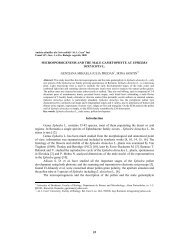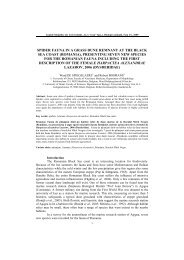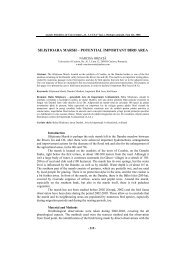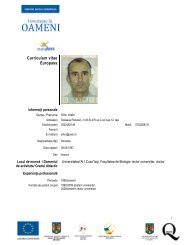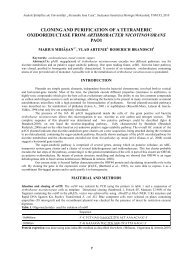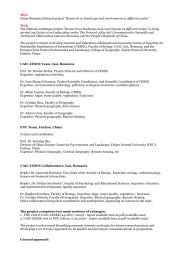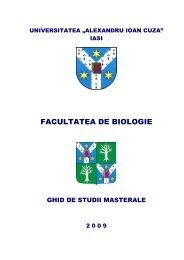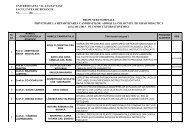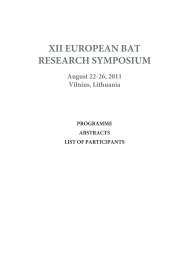Full Text
Full Text
Full Text
You also want an ePaper? Increase the reach of your titles
YUMPU automatically turns print PDFs into web optimized ePapers that Google loves.
Analele Ştiinţifice ale Universităţii “Al.I. Cuza” Iaşi, s. Biologie animală, Tom LI, 2005<br />
THE HERPETOFAUNA OF TĂŞNAD HILLS<br />
(SATU-MARE COUNTY, ROMANIA)<br />
BY<br />
SEVERUS-DANIEL COVACIU-MARCOV 1 , ISTVÁN SAS 1 ,<br />
ALFRED CICORT-LUCACIU 1 , ADRIANA ACHIM 1 , ANDREI ANDRIŢCU 1<br />
Keywords: herpetofauna, Tăşnad Hills<br />
We studied the composition and the geographic spreading of the herpethofauna from Tasnad Hills,<br />
between the years 2000 and 2003. In this region, we have identified 12 Amphibian species (Triturus<br />
vulgaris, Triturus cristatus, Triturus dobrogicus, Bombina bombina, Bombina variegata, Bufo bufo,<br />
Bufo viridis, Hyla arborea, Pelobates fuscus, Rana ridibunda, Rana dalmatina and Rana arvalis), 8<br />
Reptile species (Emys orbicularis, Lacerta viridis, Lacerta agilis, Zootoca vivipara, Anguis fragilis,<br />
Natrix natrix, Coronella austriaca, Vipera berus) and 3 species of hybrids between some amphibian<br />
species (Triturus cristatus X Triturus dobrogicus, , Bombina bombina X Bombina variegata and<br />
Rana Kl. esculenta). We also found numerous Zootoca vivipara populations in the swamps from the<br />
plain region, the species being well represented at altitudes of about 150 m. What is also important<br />
to mention is the fact that we found Triturus dobrogicus, hybrids between this species and Triturus<br />
cristatus, or the first ever discovery of Vipera berus in Tasnad Hills, at about 200 m altitude.<br />
Introduction<br />
825 scientific studies referring to Romania’s herpethofauna were made until<br />
1997 (Cogalniceanu & Andrei 1992, Andrei & Torok 1997). The majority of these<br />
papers approaches physiological, ecological and paleontological themes or talks about<br />
the Amphibians’ or the Reptiles’ parasites. There are very few studies about the<br />
composition and the geographical spreading of the herpetofauna of Romania. The<br />
herpetofauna of Romania was little investigated so far. The data about its composition<br />
and geographical spreading prior to the year 2000 is only 5 % of the real situation (Ghira<br />
et al 2002). Even nowadays, in Romania, the most complete data about the spreading of<br />
the herpetofauna are comprised within the volumes “The Fauna of the People’s Republic<br />
of Romania” that deal with this group (Fuhn 1960, Fuhn & Vancea 1961); these volumes<br />
are over 40 years old. After this no other major work about the Reptiles was ever written.<br />
Yet, there is a recent monograph about the Amphibians that analyses the whole territory<br />
of Romania (Cogălniceanu et al 2000). Comprising data about the ensemble of the<br />
herpetofauna exist only in certain regions of the country: Transylvania (Ghira et al<br />
2002), the County of Bihor (Covaciu – Marcov et al 2000, 2002, 2003 a, b), the County<br />
______________________________<br />
1 University of Oradea
Severus-Daniel Covaciu-Marcov and all.<br />
of Satu – Mare (Covaciu – Marcov et al 2004), the north of the County of Botoşani<br />
(Covaciu – Marcov et al 2003 c). The herpetofauna of the Tasnad region was little<br />
investigated in the past, a small amount of data existing in a series of papers (Ardelean<br />
1998, Cogalniceanu et al 2000, Ardelean & Karacsonyi 2002, Covaciu – Marcov 2003).<br />
A sum of all previous information and also a series of own results referring to the<br />
herpetofauna of Transylvania, and with it the one of the Tasnad region, was published in<br />
2002 (Ghira et al 2002). Even so, there is scares information on the herpetofauna of<br />
Tasnad, a fact that determined us to investigate its composition and geographical<br />
distribution.<br />
Material and methods<br />
The studied region is situated in the south-western part of Satu – Mare County,<br />
right next to the borderline with Bihor and Salaj Counties. In the southern part of the<br />
region there is a hilly landscape, the altitude of which reaches a maximum of 300 m. In<br />
the northern part of the region, there is a plain area with altitudes of about 150 m. The<br />
main water flows in this sector are the Ier and the Crana rivers and the most important<br />
town is Tăşnad.<br />
Our study needed repeated fieldtrips during several years (2000-2003). We used<br />
the method of transecting (Cogălniceanu 1997) in order to map the herpetofauna,<br />
organizing several fieldtrips in each investigated locality. All the quoted species were<br />
personally identified and assessed and the information gathered from the local people<br />
served only as a guidance. The animals were assessed mainly directly and their capture<br />
was not necessary; we used the method of direct observation (Brown 1997). When the<br />
capture of some exemplars was necessary, this was done by hand. In the case of<br />
Amphibians, during the aquatic period, the capture was done using a square drag or<br />
round nets at the end of long iron rods. After the assessing, the captured animals were<br />
released in their habitats of origin. An important part in the assessing of the composition<br />
and the geographical spreading of the herpetofauna in the investigated region played the<br />
assessment of some animals we found dead killed either by the local people or by cars.<br />
For each assessed species we made up a list with the localities where it was found. The<br />
final list comprises the newly identified localities, as we met in a certain locality in the<br />
territory several species of Amphibians and Reptiles.<br />
Results and discussions<br />
We identified 12 species of Amphibians (Triturus cristatus, Triturus<br />
dobrogicus, Triturus vulgaris, Bombina bombina, Bombina variegata, Bufo bufo, Bufo<br />
viridis, Hyla arborea, Pelobates fuscus, Rana ridibunda, Rana dalmatina şi Rana<br />
arvalis), 8 species of Reptiles (Emys orbicularis, Lacerta agilis, Lacerta viridis, Zootoca<br />
vivipara, Anguis fragilis, Natrix natrix, Coronella austriaca şi Vipera berus), and a 3<br />
category of hybrids between two species of Amphibians (Triturus cristatus şi Triturus<br />
dobrogicus, Bombina bombina şi Bombina variegata, and Rana Kl. esculenta.).<br />
Following our study, we identified 280 localities for the 20 species and a hybrid<br />
form in the south – west of the County of Caraş – Severin. Among these, 212 are new<br />
160
The herpethofauna of Tăşnad hills (Satu-Mare county, Romania)<br />
localities for the herpetofauna of Romania. The situation of the spreading of these<br />
species is laid out in Table 1, next to the mentioning of the status of their signaling<br />
(premier signaling, species priory signaled and found or not found through our<br />
investigations).<br />
Triturus vulgaris (Linnaeus 1758) is a common species in Tasnad region,<br />
present for reproduction in both the temporary ponds form the hills and the swamps and<br />
semi permanent drains from the plain.<br />
Triturus cristatus (Laurenti 1768) is rarer than the above mentioned species,<br />
being identified only in the hills, at altitudes of over 150 m. At the southern limit of its<br />
areal, this species is present in higher areas (Arntzen & Borkin 1997).<br />
Triturus dobrogicus (Kiritzescu 1903) populates only the plain areas, living in<br />
an areal in strict opposition with that of the crested newt. Prior to our study, it was only<br />
found in one locality (Arntzen et al 1997). Despite the fact that for reproduction it<br />
prefers big aquatic habitats with vegetation, we found it in drain canals alongside the<br />
roads as well.<br />
Triturus cristatus X Triturus dobrogicus. The hybrids between the two crested<br />
newt species are identified for the first time in this region but only in one place. This<br />
population is located in a series of big ponds, just between the plain and the lower hills.<br />
Although we discovered only one hybrid population, we found quite frequently<br />
individuals of one species that presented some characters of the other species. Similar<br />
situations were documented in the past (Lac 1957, Stugren & Popovici 1960, Micluta<br />
1970, Covaciu – Marcov et al 2000) proving the closeness between the two species.<br />
Bombina bombina (Linnaeus 1761) is a common species in the investigated<br />
area, present mostly in the plain sector. It is described to be a characteristic species for<br />
the lower regions from the Central and Eastern Europe (Arntzen 1978). Thus, it climbs<br />
in the hilly sector, alongside the valleys that pass through the hills. Possibly, this is due<br />
to the width of these passages, the small slope of the hills and the abundance of big<br />
humid areas, both natural and artificial. A similar situation was described in the<br />
Marghita region, in Bihor County (Covaciu – Marcov et al 2002). Although the species<br />
reaches in the hilly area, we haven’t found it at altitudes of over 200 m.<br />
Bombina variegata (Linnaeus 1758) is less common than Bombina bombina as<br />
a consequence of little higher areas in this region where the species is usually located. It<br />
has been identified by us for the first time ever in this region, living at altitudes of over<br />
150 m.<br />
Bombina bombina X Bombina variegata. We have identified for the first time<br />
ever hybrids between the two species of the Bombina genus in the Tasnad Hills’ region.<br />
They are present at the borderline between the areals of the two species, just between the<br />
plain and the hills. In that particular area, there are numerous populations of hybrids,<br />
forming a waistband between the areals of the two species, as it happens in other points<br />
of their European areal (Szymura 1993).<br />
Bufo bufo (Linnaeus 1758) is a widely spread species in the region that we<br />
studied, being present both in the plain sector and the hills<br />
161
Severus-Daniel Covaciu-Marcov and all.<br />
Bufo viridis (Laurenti 1768). Despite the fact that it is rarer than the previous<br />
species, it is a constant presence in the plain sector of the investigated area.<br />
Hyla arborea (Linnaeus 1758) is a common species in this region, present at the<br />
plain and in the hills as well. While it is more frequent in the hills, it can be also found in<br />
the reedy swampy plain areas .<br />
Pelobates fuscus (Laurenti 1768) has been identified in the plain sector quite<br />
frequently. The number of localities not so big where the species had been pointed out<br />
might be explained by the species’ nocturnal life (Fuhn 1960), Pelobates fuscus being<br />
difficult to identify outside its mating period.<br />
Rana ridibunda (Pallas 1771) is signaled for the first time ever in Tasnad region<br />
where it is a common and a widely spread species. It is also the species of Amphibians<br />
identified in the biggest number of localities. Rana ridibunda populates both swamps<br />
and permanent water flows from the plain and the valleys and streams from the hills.<br />
Rana Kl. esculenta (Linnaeus 1758) is very rare in the studied region, being<br />
identified in a single location, at Andrid, in a big permanent swamp. This habitat<br />
resembles to those where Rana Kl. esculenta was identified in the Oaş region (Covaciu<br />
– Marcov et al 2004).<br />
Rana dalmatina (Bonaparte 1839) is an ordinary species in the investigated<br />
area, living both the afforested and the swampy plain sectors.<br />
Rana arvalis (Nilsson 1842) is relatively widespread in the lower regions with a<br />
high humidity level. It populates mostly large deforested swamps from the plain but it<br />
also appears in the humid afforested sectors from the lower part of the hills.<br />
Emys orbicularis (Linnaeus 1758) is rare in this region. We have identified it<br />
only in one place, at Andrid, in the humid areas coterminous to the Ier River.<br />
Lacerta agilis (Linnaeus 1758) is the most common lizard from the Tasnad<br />
region, being found in a big number of localities.<br />
Lacerta viridis (Laurenti 1768) is a relatively rare species, present only in the<br />
hilly sector, at altitudes of over 150m. It populates the hills’ slopes with bushy<br />
vegetation or the skirts of the forests.<br />
Zootoca vivipara (Jacquin 1787) is a common lizard in the region that we<br />
studied, being identified in 14 localities out of which 12 represent premiers for the<br />
herpetofauna of Romania. The species is present in the plain areas of about 150 m<br />
altitude. Thus, it can reach, alongside the valleys and among the hills, the Crasna River’s<br />
meadow, until the borderline between Satu – Mare and Salaj Counties, at Supuru de<br />
Sus. It is also very likely that the species is present in the plain in Salaj County. Just like<br />
in other cases where it is present in the north-western plains of Romania (Covaciu –<br />
Marcov et al 2002, 2004) Zootoca vivipara populates swamps and wide humid areas. In<br />
Romania, this species was, for a long time, considered to be a mountain lizard (Fuhn &<br />
Vancea 1961) even with the fact that in Romania’s neighbors plain population were<br />
discovered a long time ago (Kopany 1950, Lac & Kluch 1968, Dely 1978 a, b). Just<br />
recently, some populations were identified in lower regions of Romania as well, both<br />
the Western Plain (Ghira at al 2002, Covaciu – Marcov et al 2002, 2004) and the<br />
northern part of the Moldavian Plain (Covaciu – Marcov et al 2003 c). Numerous<br />
162
The herpethofauna of Tăşnad hills (Satu-Mare county, Romania)<br />
populations identified in plain sectors from the northern part of Romania suggest a wider<br />
spreading of this species in Tasnad region, underlining the necessity of investigating the<br />
factors that condition the species’ spreading at the plain.<br />
Anguis fragilis (Linnaeus 1758) is a premiere discovery for the investigated<br />
region, being a rare species that lives in the afforested areas of the hills.<br />
Natrix natrix (Linnaeus 1758) is a common snake in the region that we studied.<br />
It is spread across a large number of localities, both swampy sectors from the plain and<br />
afforested areas from the hills.<br />
Coronella austriaca (Laurenti 1768) is a rare species in this region. We have<br />
identified it only in one locality, in the hills, at the borderline between Satu – Mare and<br />
Bihor Counties.<br />
Vipera berus (Linnaeus 1758) has been identified by us for the first time ever in<br />
this region but only in one locality, at Cean, at an altitude of about 200m. It is<br />
remarkable the fact that the viper comes down in this region at such low altitudes<br />
because in Romania it is considered to be a mountain element (Nilson & Andern 1997).<br />
At Cean, it is present in an area afforested by oak trees. It seems that in the northwestern<br />
parts of Romania Vipera berus is present in a wide scale of altitudes, in the<br />
lower part of the hills (Covaciu – Marcov et al 2000, 2003 d) and even at the plain, too<br />
(Ghira et al 2002, Covaciu – Marcov et al 2004).<br />
Conclusions<br />
We studied the composition and the geographical spreading of the herpetofauna<br />
from Tasnad Hills, between the years 2000 and 2003. In this region, we have identified<br />
12 species of Amphibians (Triturus vulgaris, Triturus cristatus, Triturus dobrogicus,<br />
Bombina bombina, Bombina variegata, Bufo bufo, Bufo viridis, Hyla arborea, Pelobates<br />
fuscus, Rana ridibunda, Rana dalmatina and Rana arvalis), 8 Reptile species (Emys<br />
orbicularis, Lacerta viridis, Lacerta agilis, Zootoca vivipara, Anguis fragilis, Natrix<br />
natrix, Coronella austriaca, Vipera berus) and 3 species of hybrids between some<br />
amphibian species (Triturus cristatus X Triturus dobrogicus, , Bombina bombina X<br />
Bombina variegata and Rana Kl. esculenta). We also found numerous Zootoca vivipara<br />
populations in the swamps from the plain region, the species being well represented at<br />
altitudes of about 150 m. What is also important to mention is the fact that we found<br />
Triturus dobrogicus, hybrids between this species and Triturus cristatus, or the first ever<br />
discovery of Vipera berus in Tasnad Hills, at about 200 m altitude.<br />
163
Severus-Daniel Covaciu-Marcov and all.<br />
Bibliography<br />
1. Andrei, M., & Torok, Z., 1997 - Travaux du Museum D’Histoire Naturelle<br />
“Grigore Antipa”, 39, 209 – 240.<br />
2. Ardelean, G., 1998 - Fauna judeţului Satu – Mare, Ţara Oaşului, Culmea<br />
Codrului şi Câmpia Someşului. Arad – “Vasile Goldiş” University<br />
Press.<br />
3. Ardelean, G., Karácsonyi, C., 2002 - Flora şi Fauna Văii Ierului (înainte şi<br />
după asanare). Ed. Bion, Satu – Mare.<br />
4. Arntzen, J.W., 1978 - J. Biogeogr. 5, 339 – 345.<br />
5. Arntzen, J.W., Borkin, L., 1997 - In: Gasc, J. P., (ed.). Atlas of Amphibians and<br />
Reptiles in Europe, pp. 76 – 77, Museum National D’Histoire<br />
Naturelle, Paris.<br />
6. Arntzen, J.W., Butger, R.J.F., Cogălniceanu, D., Wallis, G.P., 1997 - Amphibia<br />
– Reptilia, 18, 133 – 142.<br />
7. Brown, L.J., 1997- Journal of Herpetology, 31 (3), 410 – 419.<br />
8. Cogălniceanu, D. 1997 - Practicum de ecologie al Amfibienilor – Metode şi<br />
tehnici în studiul ecologiei Amfibienilor, Ed. Universităţii din<br />
Bucureşti.<br />
9. Cogălniceanu, D., Andrei, M., 1992 - Travaux du Museum D’Histoire Naturelle<br />
“Grigore Antipa”, 32, 331 – 346.<br />
10. Cogălniceanu, D., Aioanei, F., Bogdan, M., 2000 - Amfibienii din România,<br />
Determinator, Ed. Ars Docendi, Bucureşti.<br />
11. Covaciu-Marcov, S.D., Ghira, I., Venczel, M., 2000 - Nymphaea, Folia naturae<br />
Bihariae, 28, 143 – 158.<br />
12. Covaciu-Marcov, S.D., Telcean, I.C., Cupşa, D., Cadleţ, D., Zsurka, R., 2002 -<br />
Analele Universităţii din Oradea, Fasc. Biologie, 9, 257 – 269.<br />
13. Covaciu-Marcov, S.D., 2003 - Satu-Mare, Studii şi Comunicări, Seria Ştiinţele<br />
Naturii, II – III, 2001 – 2002, 191 – 196.<br />
14. Covaciu-Marcov, S.D., Telcean, I.C., Sala, G., Sas, I., Cicort, A., 2003 - a.<br />
România. Nymphaea, Folia naturae Bihariae, 30, 127 – 141.<br />
15. Covaciu-Marcov, S.D., Cupşa, D., Telcean, I.C., Sas, I., Cicort A., 2003 - b.<br />
Muzeul Olteniei Craiova, Oltenia, Studii şi Comunicări Ştiinţele<br />
Naturii, 19, 189 – 194.<br />
16. Covaciu-Marcov, S.D., Sas, I., Cicort, A., Kovács É.H., 2003 - c. Studii şi<br />
Cercetări Ştiinţifice, Biologie, 8, 201 – 205.<br />
17. Covaciu-Marcov, S.D., Sas, I., Cupşa, D., Telcean, I.C., Zsurka, R. 2003 - d.<br />
Analele Universităţii din Oradea, Fasc. Biologie, 10, 81-96<br />
164
The herpethofauna of Tăşnad hills (Satu-Mare county, Romania)<br />
18. Covaciu-Marcov, S.D., Ghira, I., Sas, I., 2004 - Mediul, Cercetare, Protecţie,<br />
Gestiune, Cluj-Napoca, 2, 107 – 112.<br />
19. Dely, O.G., 1978 - a. Hullok – Reptilia, Fauna Hungariae, 130, 20(4),<br />
Akademiai Kiado, Budapest.<br />
20. Dely, O.G., 1978 - b. Vrtebrata Hungarica, 18, 7 – 53.<br />
21. Ghira, I., Venczel, M., Covaciu-Marcov, S.D., Mara, G., Ghile, P., Hartel, T.,<br />
Torok, Z., Farkas, L., Racz, T., Farcas, Z., Brad, T., 2002 - Nymphaea,<br />
Folia naturae Bihariae, 19, 145 – 203.<br />
22. Fuhn, I., 1960 - “Fauna R.P.R.”, vol. XIV, fascicola I, Amphibia, Editura<br />
Academiei R.P.R., Bucureşti.<br />
23. Fuhn, I., Vancea, Şt., 1961 - “Fauna R.P.R.”, vol. XIV, Fascicola II, Reptilia,<br />
Editura Academiei R.P.R., Bucureşti.<br />
24. Koppanyi, T., 1950 - Debreceni Tudomany-egyetem Biologiai Intezeteinek.<br />
Evkonyve, 1, 267.<br />
25. Lac, J., 1957 - Na Slovensku a poznamky k ich ekologii. Biologia, 12, 10, 724 –<br />
745.<br />
26. Lac, J., Kluch, E., 1968 - Zool. Listy., 17, 157 – 173.<br />
27. Nilson, G., Andren, C., 1997 - In: Gasc, J.P., (ed.). Atlas of Amphibians and<br />
Reptiles in Europe, pp. 388 – 389, Museum National D’Histoire<br />
Naturelle, Paris.<br />
28. Stugren, B., Popovici, M., 1960 - Musei historico - naturalis Hungarici, 2 (2),<br />
189 – 198.<br />
29. Szymura, J. M., 1993 - In: Harrison, R.G. (eds.), Hibrid zones and the<br />
evolutionary process, pp 261 – 289, Oxford: Oxford University Press.<br />
165
Severus-Daniel Covaciu-Marcov and all.<br />
Anex 1., The spreading of Amphibians in Tăşnad Hills<br />
(T.v.- Triturus vulgaris, T.c.-Tr. cristatus, T.d.- Tr. dobrogicus, TX- Tr. cristatus x Tr.<br />
dobrogicus, B.b.- Bombina bombina, B.v.- Bombina variegata, Bx- B. bombina X B.<br />
variegata, P.f.- Pelobates fuscus, Buf.- Bufo bufo, Buv.- B. viridis, H.a.- Hyla arborea,<br />
R.r.- Rana ridibunda, R.e.- Rana esculenta, R.d.- Rana dalmatina, R.a.- Rana arvalis,)<br />
Tv Tc Td T Bb Bv B Pf Bu Bu Ha Rr Re Rd Ra<br />
X X f v<br />
Acâş X - X - X - - X - X X X - - -<br />
Ady Endre - - - - S - - O O S O X - - -<br />
Andrid S O S - S - - X X X X X X X S<br />
Blaja - - - - X - - - X - X X - X -<br />
Căuaş S O - - S - - S S O O X - X S<br />
Cehal - - - - - X - - X - X X - X -<br />
Cehăluţ - - - - X - X - X - X X - X -<br />
Cean X X - - - X - - X - X - - X -<br />
Chegea X X - - - X - - X - - - - X -<br />
Chereuşa O O - - X - - - S - - X - S -<br />
Cig X - - - O - - - S O - X - X O<br />
Dindeşti S O - - S - - X S S - X - X S<br />
Eriu –Sâncrai S O X - X - - O S O O X - X O<br />
Ghileşti S O - - X - - - O O - X - - -<br />
Giungi S O - - X - - - - - - X - X -<br />
Hotoan - - - - X - - - S - - X - - O<br />
Irina X - - - S - - X S S - X - X S<br />
Mihăieni X - X - X - - - - - - X - - -<br />
Orbău - X - - X - X - X - X X - X -<br />
Pir X O - - S - - O S S - X - S -<br />
Piru Nou X - - - X - - X S X - X - S S<br />
Portiţa - - - - S - - X S O - X - X S<br />
Santău S O - - S - - - S O - X - S S<br />
Satu Mic X O X - S - - - - - - X - X -<br />
Săcăşeni X X - - X X X - X - - - - X S<br />
Sărăuad X X - - X X X - X - - X - X S<br />
Săuca - - - - X - - - X - - X - - -<br />
Sechereşa X - - - - - - - X - X - - X -<br />
Silvaş - - - - X - - - X - - X - X S<br />
Sudurău - - - - S - - - O O - - - O O<br />
Supur (Supuru de Jos) X X - X X - - X X - - X - X -<br />
Supuru de Sus X X - - X X X - - X X X - X -<br />
Tăşnad X O - - S - - O S O X X - X S<br />
Unimăt X - - - X X X - X - - - - - -<br />
166
The herpethofauna of Tăşnad hills (Satu-Mare county, Romania)<br />
Tv Tc Td T Bb Bv B Pf Bu Bu Ha Rr Re Rd Ra<br />
X X f v<br />
Valea Morii - - - - X - - - X - - X - - -<br />
Vezendiu - - - - X - - - X - O X - X -<br />
Σ X 16 7 4 1 20 7 6 7 16 4 10 30 1 23 -<br />
Σ S 7 - 1 - 11 - - 1 12 4 - - - 4 11<br />
Σ O 1 11 - - 1 - - 4 3 8 4 - - 1 4<br />
X- new localities, O- localities with the species, but don’t found by us, S- localities with<br />
the species, refounded by us<br />
Anex 2., The spreading of Reptiles in Tăşnad Hills<br />
(L.a.- Lacerta agilis, L.v.- Lacerta viridis, Z.v.- Zootoca vivipara, A.f.- Anguis fragilis,<br />
C.a- Coronella austriaca, N.n.- Natrix natrix, V.b.- Vipera berus, E.o.- Emys<br />
orbicularis)<br />
La Lv Zv Af Ca Nn VbEo<br />
Acâş X - - - - X - -<br />
Ady Endre S O S - - O - -<br />
Andrid X - X - - X - S<br />
Blaja X X - - - X - -<br />
Căuaş S O S - - S - -<br />
Cehal - - - - - X - -<br />
Cehăluţ X X X - - X - -<br />
Cean X X - X X - X -<br />
Chegea X X - - - X - -<br />
Chereuşa X - - - - S - -<br />
Cig S O X - - X - -<br />
Dindeşti S O - - - X - -<br />
Eriu –Sâncrai S O X - - - - -<br />
Ghileşti S - X - - - - -<br />
Giungi - - - - - - - -<br />
Hotoan S - - - - - - -<br />
Irina S O X - - - - -<br />
Mihăieni - - - - - X - -<br />
Orbău - - - - - X - -<br />
Pir X - - - - X - -<br />
Piru Nou X - - - - X - -<br />
Portiţa S O X - - - - -<br />
Santău S - - - - S - -<br />
Satu Mic X - X - - - - -<br />
Săcăşeni X X X X - X - -<br />
167
Severus-Daniel Covaciu-Marcov and all.<br />
La Lv Zv Af Ca Nn VbEo<br />
Sărăuad X X X X - X - -<br />
Săuca - - - - - - - -<br />
Sechereşa - - - - - - - -<br />
Silvaş X - - - - X - -<br />
Sudurău S - - - - - - -<br />
Supur (Supuru de Jos) X - - - - X - -<br />
Supuru de Sus X - X - - X - -<br />
Tăşnad X - X - O X - -<br />
Unimăt X - - - - - - -<br />
Valea Morii X - - - - - - -<br />
Vezendiu X O - - - - - -<br />
Σ X 19 6 12 3 1 18 1 -<br />
Σ S 11 - 2 - - 3 - 1<br />
Σ O - 8 - - 1 1 - -<br />
X- new localities, O- localities with the specie, but don’t found by us, S- localities with<br />
species, refounded by us<br />
168



